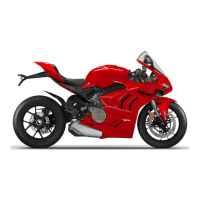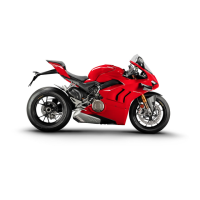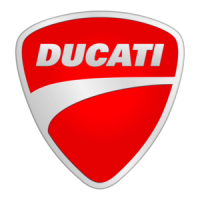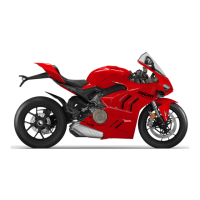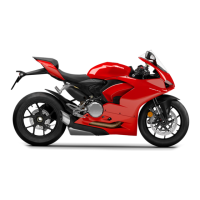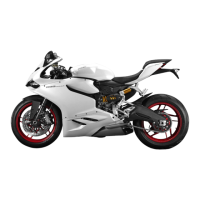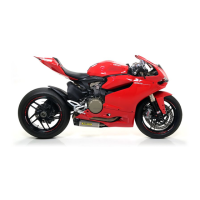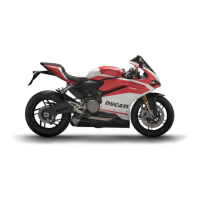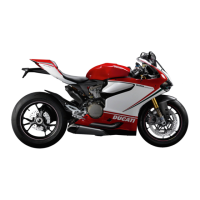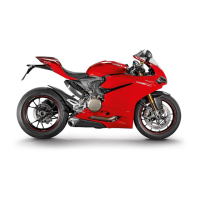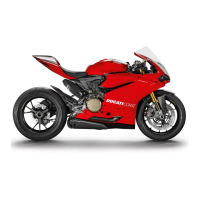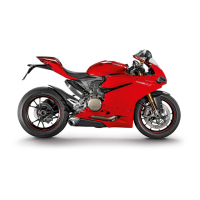Do you have a question about the Ducati Panigale V4 R and is the answer not in the manual?
Welcome, manual purpose, and safe riding advice.
Identifies fuel compatibility and safety precautions during refueling.
Guides on proper luggage arrangement and weight distribution for safety.
Overview of the motorcycle's digital instrument cluster and its indicators.
Detailed explanation of the ABS system, its modes, and cornering function.
Lists manufacturers' addresses for radio equipment installed in the vehicle.
Lists the information shown on the instrument panel in TRACK display mode.
Lists the information shown on the instrument panel in ROAD display mode.
Lists primary data displayed on the standard screen.
Details the adjustable parameters for riding aids.
Lists various functions accessible through the instrument panel's menu system.
Lists parameters and their current settings, allowing quick level changes.
Details the process for quick level changes of adjustable parameters.
Provides guidance on choosing the appropriate DTC sensitivity level based on conditions.
Guides on selecting the correct DWC sensitivity level based on rider experience and track conditions.
Advice on choosing the most suitable DSC intervention level based on riding style.
Table detailing EBC intervention levels and default settings for riding modes.
Guidance on selecting the appropriate ABS sensitivity level based on rider experience and conditions.
Explains how to view and understand the total distance traveled by the motorcycle.
Details the functionality and reset procedure for Trip Meter 1.
Explains how average fuel consumption is calculated and displayed.
Describes the display and calculation of average vehicle speed.
Explains how trip time is calculated and displayed.
Details how ambient air temperature is displayed and potential display issues.
Explains the function and display of the partial fuel reserve counter.
Describes the functionality and reset procedure for Trip Meter 2.
Explains how instantaneous fuel consumption is calculated and displayed.
Explains how to enable/disable and use the Lap time recording function.
Details how to activate, deactivate, and manage the music player.
Explains how to customize settings for each riding mode.
Details how to set DTC, DWC, and DSC levels within each riding mode.
Describes how to disable or set the DTC level for a selected riding mode.
Describes how to disable or set the DWC level for a selected riding mode.
Describes how to disable or set the DSC level for a selected riding mode.
Allows restoring default DTC, DWC, and DSC settings for a specific riding mode.
Explains how to customize engine power settings for each riding mode.
Describes how to disable or set the ABS level for a selected riding mode.
Describes how to disable or set the EBC level for each riding mode.
Explains how to disable or enable the DQS for a selected riding mode.
Allows selecting the main screen display mode associated with each riding mode.
Restores default parameters for a specific riding mode.
Restores default values for all riding modes and their parameters.
Allows the user to activate or modify the motorcycle's PIN code.
Allows the user to activate or modify an existing PIN code.
Explains how to enable/disable and manage the Lap time recording function.
Details how to view recorded lap data and session information.
Shows the best laps recorded for each session, including time and performance data.
Explains how to view detailed lap data for specific recorded sessions.
Describes the procedure for deleting all recorded lap data.
Allows adjusting the instrument panel's display backlighting intensity.
Guides the user on how to set the motorcycle's date and time.
Allows changing the units of measurement for various displayed values.
Provides information on upcoming service deadlines and maintenance schedules.
Allows the user to set a speed limit for the Pit Lane Speed Limiter.
Guides through the procedure for calibrating tyre rolling circumference and final drive ratio.
Allows setting the DRL light to automatic or manual mode.
Manages paired Bluetooth devices, including visualization, addition, and removal.
Allows enabling/disabling DDA, viewing memory usage, and deleting stored data.
Allows setting the automatic turn indicator switch-off strategy.
Allows viewing vehicle battery voltage and engine RPM.
Explains how incoming calls are displayed and managed via the instrument panel.
Describes the display and controls for managing an active phone call.
Allows recalling and calling the last number from the call history.
Explains how missed calls are indicated on the instrument panel.
Describes how received messages or emails are indicated on the instrument panel.
Explains the initial oil service warning triggered at a specific mileage.
Details countdown indications for various service types.
Explains warnings triggered when specific service thresholds are reached.
Warns the rider about potential icy road conditions based on external temperature.
Alerts the user when the vehicle battery voltage is low.
Describes the operation of headlights, DRL, and parking lights.
Explains DRL operation in manual mode and safety considerations.
Explains the automatic turn indicator cancellation feature and its settings.
Describes the function of the hazard lights for emergency signaling.
Illustrates the location and names of all motorcycle controls.
Details the positions and functions of the ignition switch and steering lock.
Explains the functions of the switches on the left handlebar.
Guides on how to adjust the gearchange pedal position.
Identifies key components and their locations on the motorcycle.
Provides suggested suspension settings for the Öhlins front fork in different riding modes.
Provides suggested suspension settings for the Öhlins rear shock absorber in different riding modes.
Guides on adjusting the rear swinging arm pivot height for track use.
Provides guidelines for the initial running-in period of the motorcycle.
Guidance on proper braking techniques and downshifting.
Explains the meaning of fuel compatibility labels (E5, E10).
Explains the need to remove fairings for certain maintenance tasks and refitting precautions.
Advises to have air filter maintenance performed by a Ducati Dealer.
Explains how to identify and address potential issues with the clutch system.
Steps for preparing to charge the motorcycle battery.
Instructions for connecting the battery charger to the battery terminals.
Instructions for safely disconnecting the battery charger.
Advises on tire repair, replacement, and balancing after puncture.
Details routine maintenance tasks performed by authorized dealers.
Lists the overall weight, weight without fluids, and maximum allowed weight.
Provides the physical dimensions of the motorcycle.
Details the Desmodromic timing system components.
Technical specifications for the front brake system.
Technical specifications for the rear brake system.
Details the specifications and adjustability of the front fork.
Details the specifications and adjustability of the rear shock absorber.
Describes the adjustable Öhlins steering damper.
Details the layout and components of the exhaust system.
Specifies the LED components used for headlights and DRL.
Details the types of LED and bulb indicators used.
Lists the LED components used for taillights, stop lights, and license plate light.
Lists the standard wire colours used in the electrical system.
Welcome, manual purpose, and safe riding advice.
Identifies fuel compatibility and safety precautions during refueling.
Guides on proper luggage arrangement and weight distribution for safety.
Overview of the motorcycle's digital instrument cluster and its indicators.
Detailed explanation of the ABS system, its modes, and cornering function.
Lists manufacturers' addresses for radio equipment installed in the vehicle.
Lists the information shown on the instrument panel in TRACK display mode.
Lists the information shown on the instrument panel in ROAD display mode.
Lists primary data displayed on the standard screen.
Details the adjustable parameters for riding aids.
Lists various functions accessible through the instrument panel's menu system.
Lists parameters and their current settings, allowing quick level changes.
Details the process for quick level changes of adjustable parameters.
Provides guidance on choosing the appropriate DTC sensitivity level based on conditions.
Guides on selecting the correct DWC sensitivity level based on rider experience and track conditions.
Advice on choosing the most suitable DSC intervention level based on riding style.
Table detailing EBC intervention levels and default settings for riding modes.
Guidance on selecting the appropriate ABS sensitivity level based on rider experience and conditions.
Explains how to view and understand the total distance traveled by the motorcycle.
Details the functionality and reset procedure for Trip Meter 1.
Explains how average fuel consumption is calculated and displayed.
Describes the display and calculation of average vehicle speed.
Explains how trip time is calculated and displayed.
Details how ambient air temperature is displayed and potential display issues.
Explains the function and display of the partial fuel reserve counter.
Describes the functionality and reset procedure for Trip Meter 2.
Explains how instantaneous fuel consumption is calculated and displayed.
Explains how to enable/disable and use the Lap time recording function.
Details how to activate, deactivate, and manage the music player.
Explains how to customize settings for each riding mode.
Details how to set DTC, DWC, and DSC levels within each riding mode.
Describes how to disable or set the DTC level for a selected riding mode.
Describes how to disable or set the DWC level for a selected riding mode.
Describes how to disable or set the DSC level for a selected riding mode.
Allows restoring default DTC, DWC, and DSC settings for a specific riding mode.
Explains how to customize engine power settings for each riding mode.
Describes how to disable or set the ABS level for a selected riding mode.
Describes how to disable or set the EBC level for each riding mode.
Explains how to disable or enable the DQS for a selected riding mode.
Allows selecting the main screen display mode associated with each riding mode.
Restores default parameters for a specific riding mode.
Restores default values for all riding modes and their parameters.
Allows the user to activate or modify the motorcycle's PIN code.
Allows the user to activate or modify an existing PIN code.
Explains how to enable/disable and manage the Lap time recording function.
Details how to view recorded lap data and session information.
Shows the best laps recorded for each session, including time and performance data.
Explains how to view detailed lap data for specific recorded sessions.
Describes the procedure for deleting all recorded lap data.
Allows adjusting the instrument panel's display backlighting intensity.
Guides the user on how to set the motorcycle's date and time.
Allows changing the units of measurement for various displayed values.
Provides information on upcoming service deadlines and maintenance schedules.
Allows the user to set a speed limit for the Pit Lane Speed Limiter.
Guides through the procedure for calibrating tyre rolling circumference and final drive ratio.
Allows setting the DRL light to automatic or manual mode.
Manages paired Bluetooth devices, including visualization, addition, and removal.
Allows enabling/disabling DDA, viewing memory usage, and deleting stored data.
Allows setting the automatic turn indicator switch-off strategy.
Allows viewing vehicle battery voltage and engine RPM.
Explains how incoming calls are displayed and managed via the instrument panel.
Describes the display and controls for managing an active phone call.
Allows recalling and calling the last number from the call history.
Explains how missed calls are indicated on the instrument panel.
Describes how received messages or emails are indicated on the instrument panel.
Explains the initial oil service warning triggered at a specific mileage.
Details countdown indications for various service types.
Explains warnings triggered when specific service thresholds are reached.
Warns the rider about potential icy road conditions based on external temperature.
Alerts the user when the vehicle battery voltage is low.
Describes the operation of headlights, DRL, and parking lights.
Explains DRL operation in manual mode and safety considerations.
Explains the automatic turn indicator cancellation feature and its settings.
Describes the function of the hazard lights for emergency signaling.
Illustrates the location and names of all motorcycle controls.
Details the positions and functions of the ignition switch and steering lock.
Explains the functions of the switches on the left handlebar.
Guides on how to adjust the gearchange pedal position.
Identifies key components and their locations on the motorcycle.
Provides suggested suspension settings for the Öhlins front fork in different riding modes.
Provides suggested suspension settings for the Öhlins rear shock absorber in different riding modes.
Guides on adjusting the rear swinging arm pivot height for track use.
Provides guidelines for the initial running-in period of the motorcycle.
Guidance on proper braking techniques and downshifting.
Explains the meaning of fuel compatibility labels (E5, E10).
Explains the need to remove fairings for certain maintenance tasks and refitting precautions.
Advises to have air filter maintenance performed by a Ducati Dealer.
Explains how to identify and address potential issues with the clutch system.
Steps for preparing to charge the motorcycle battery.
Instructions for connecting the battery charger to the battery terminals.
Instructions for safely disconnecting the battery charger.
Advises on tire repair, replacement, and balancing after puncture.
Details routine maintenance tasks performed by authorized dealers.
Lists the overall weight, weight without fluids, and maximum allowed weight.
Provides the physical dimensions of the motorcycle.
Details the Desmodromic timing system components.
Technical specifications for the front brake system.
Technical specifications for the rear brake system.
Details the specifications and adjustability of the front fork.
Details the specifications and adjustability of the rear shock absorber.
Describes the adjustable Öhlins steering damper.
Details the layout and components of the exhaust system.
Specifies the LED components used for headlights and DRL.
Details the types of LED and bulb indicators used.
Lists the LED components used for taillights, stop lights, and license plate light.
Lists the standard wire colours used in the electrical system.
| Power | 221 hp (162 kW) @ 15, 250 rpm |
|---|---|
| Transmission | 6-speed with Ducati Quick Shift (DQS) up/down EVO 2 |
| Frame | Aluminum alloy Front Frame |
| Rear Brake | 245 mm disc, 2-piston caliper |
| Front Tire | 120/70 ZR17 |
| Rear Tire | 200/60 ZR17 |
| Warranty | 24 months unlimited mileage |
| Maintenance Service Intervals | 12, 000 km (7, 500 miles) / 12 months |
| Valve Clearance Check | 24, 000 km (15, 000 miles) |
| Engine Type | 4 valves per cylinder |
| Torque | 83 lb-ft (112 Nm) @ 11, 500 rpm |
| Fuel Capacity | 4.23 US gal (16.0 l) |
| Brakes | 245mm disc |
| Front Suspension | Ohlins NPX 25/30 pressurized fork with TiN treatment, fully adjustable |
| Rear Suspension | Ohlins TTX36 shock, fully adjustable |
| Front Brake | Dual 330mm semi-floating discs, radially mounted Brembo Monobloc Stylema® (M4.30) 4-piston calipers |
| Wheels | Forged aluminum wheels |
| Safety Equipment | Ducati Traction Control (DTC), Ducati Slide Control (DSC), Ducati Wheelie Control (DWC), Engine Brake Control (EBC), Cornering ABS EVO |
| Standard Equipment | Ducati Power Launch (DPL), Ducati Quick Shift (DQS) up/down |
| Instrumentation | TFT color display |
